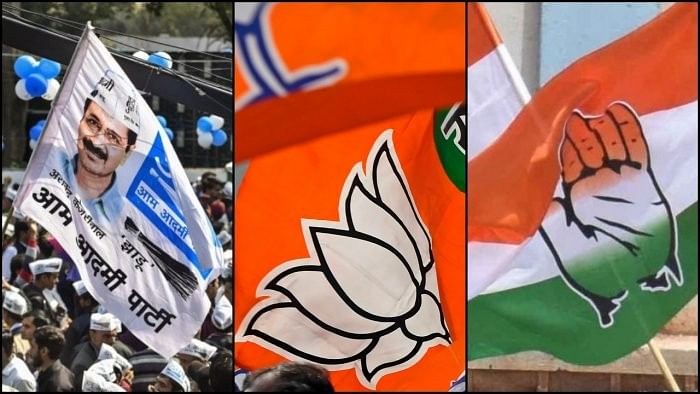
File images showing the flags of AAP, BJP and Congress parties.
Credit: DH, PTI Photos
As political parties in India and their candidates are once again out rallying in the streets of the country to woo the voters, a general speculation that haunts every Indian is "what if no party gains the clear majority in the Parliament?" When none of the parties or coalition blocs are able to get the required numbers in the House to prove a majority, the situation results in a 'hung parliament' — meaning no party can claim to have enough elected member representatives in the Lower House to form the government.
So what makes majority?
To register majority in the Indian Parliament, a party or a coalition must bag more than 50 per cent seats in the Lower House, which is the Lok Sabha. There are a total of 543 seats in the Lok Sabha, with two nominated members — making it 545. A party defending its regime during the elections must win 50 per cent of the 543 seats — at least 272 — to emerge victorious in the polls.
No majority at all! What then?
The President's intervention becomes must when the all political parties in the House fails to register a clear majority. The President calls upon the leader of the largest single party to form the government— this being the first possible option to elect a party or a coalition, reported Times of India.
In case the first option does not work, the President then invites leader of the largest 'pre'-poll alliance to form the government, failing which the President next calls upon the leader of the single largest 'post'-poll alliance to form the government, as per the Sarkaria Commission.
According to the Ministry of Home Affairs, the Sarkaria Commission was formed by the Indian government in 1988 to "examine and review the working of the existing arrangements between the Union and the States, and making recommendations as to the changes and measures needed." The Commission after conducting several studies, eliciting information, holding discussions and after detailed deliberations submitted its 1600-page report in January 1988, which entails 247 recommendations spreading over 19 Chapters.
What if there is still no majority proven?
Going by the first scenario where the President invites leader of the single largest party to form the government: there is a possibility that none of the parties or coalition in the House extend support to the leader of the single largest party. The President under such a situation is responsible to use her judgement and conduct discussions to arrive on a decision.
After the discussions, the next step is President's call for a vote of confidence on the floor of the Parliament. The party or the coalition that prove majority in such a voting process is elected. However, re-election can be held if the chosen party or coalition fail to perform under their governance. This is also done with the President's discretion.
One such instance when no party could prove majority in the House was in 1998, during the 12th Lok Sabha when late Atal Bihari Vajpayee was chosen to be the prime minister, but almost a year later, in 1999, the government collapsed and he had to step down as the PM after AIADMK withdrew its support to the BJP. The saffron brigade had bagged 182 seats of the 543 total followed by Congress that garnered 141 seats. All other regional parties combined, won 101 seats.
Apart from the aforementioned situations, there is also a possibility for the formation of a minority government, wherein the party having most members is allowed to form the government— on a condition that it has support from other minor parties and independent legislators.
As the 17th Lok Sabha term is set to dissolve, voting for 18th Lok Sabha is set to commence from April 19, 2024, in seven phases across the country. The results will be announced on June 4 is when the counting will be held, while the same for Arunachal Pradesh and Sikkim will be held on June 2, 2024.